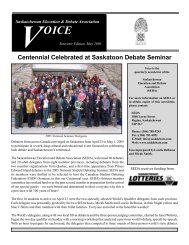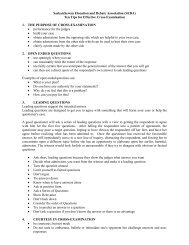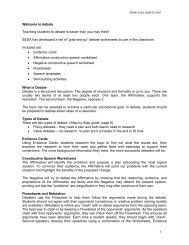Human Cloning - Saskatchewan Elocution and Debate Association
Human Cloning - Saskatchewan Elocution and Debate Association
Human Cloning - Saskatchewan Elocution and Debate Association
Create successful ePaper yourself
Turn your PDF publications into a flip-book with our unique Google optimized e-Paper software.
If Not Today, Tomorrow Page 3 of 4<br />
New Scientist, January 11, 2003<br />
<strong>Cloning</strong> companies claim most<br />
cow clones that do survive are<br />
perfectly healthy. They point out<br />
that "large offspring syndrome"<br />
also occurs in cattle created by<br />
IVF, so the problem may be poor<br />
culture conditions rather than<br />
cloning itself. And pig cloners<br />
report far fewer birth defects,<br />
suggesting some species are<br />
easier to clone than others.<br />
However, other scientists say it is<br />
too early to declare any clone<br />
normal. It is just six years since<br />
the birth of Dolly, the first cloned<br />
mammal, <strong>and</strong> few clones other<br />
than mice have yet lived out their<br />
natural lifespan. Dolly herself<br />
prematurely developed arthritis.<br />
What little we know suggests<br />
clones might die earlier than<br />
normal. A year ago, Japanese<br />
researchers reported that 83 per<br />
cent of their cloned mice died<br />
after two years — over three<br />
times the rate for mice created by<br />
IVF or normal breeding. And<br />
some tests on cows suggest that<br />
clones are even less bright than<br />
the average bovine.<br />
Would-be human cloners have<br />
always pledged to screen out<br />
defective embryos to eliminate<br />
problems encountered with<br />
animal clones. Boisselier told<br />
New Scientist that Clonaid had<br />
looked at gene expression in the<br />
cloned human embryos it created<br />
<strong>and</strong> found no problems, but she<br />
would not reveal any details.<br />
Most experts say comprehensive<br />
tests of this kind can't be done,<br />
because the genetic defects in<br />
clones are believed to be too<br />
subtle <strong>and</strong> too widespread to<br />
screen for with existing<br />
technology. Researchers recently<br />
showed that there are dramatic<br />
abnormalities in the level of<br />
activity of hundreds of genes in<br />
the placentas of cloned mice.<br />
They also detected a similar but<br />
lower level of genetic chaos in the<br />
livers of newborn mice clones.<br />
Measuring <strong>and</strong> predicting the<br />
effects of these abnormalities in<br />
every tissue of a developing fetus<br />
is impossible.<br />
HOW CAN WE TELL IT A CLONE<br />
REALLY IS A CLONE?<br />
Verifying whether a baby is a<br />
clone or not is straightforward<br />
with modern DNA fingerprinting<br />
technology. But with all the<br />
secrecy surrounding maverick<br />
cloners, satisfying sceptical<br />
scientists will not be easy.<br />
"Extraordinary claims have to be<br />
supported by extraordinary<br />
evidence," says the inventor of<br />
DNA fingerprinting, Alec<br />
Jeffreys of the University of<br />
Leicester. "That means bringing<br />
into force the full weight of<br />
forensic DNA typing systems,<br />
including all the safeguards <strong>and</strong><br />
procedures that exist in that<br />
technology."<br />
DNA fingerprinting looks at<br />
highly variable regions of our<br />
genome, in which short<br />
sequences are repeated many<br />
times. The number of times a<br />
particular sequence is repeated<br />
varies from person to person, <strong>and</strong><br />
on each of the two copies of each<br />
chromosome. The chances of two<br />
people having the same pattern is<br />
extremely small.<br />
A normal child's DNA fingerprint<br />
would be a combination of those<br />
of its parents. But a cloned baby<br />
would have just one "parent", <strong>and</strong><br />
their DNA fingerprints should be<br />
exactly the same. Of course,<br />
mutations can occur in any cell in<br />
the body, so it is possible that the<br />
clone's profile would differ very<br />
slightly from the "parent",<br />
requiring further testing.<br />
However, it is not enough for<br />
self-proclaimed cloners to<br />
provide matching samples. They<br />
have to prove that one sample is<br />
from the child <strong>and</strong> the other from<br />
the person cloned. Given the<br />
controversy surrounding such<br />
claims, it is crucial that the entire<br />
process is foolproof. "What you<br />
need is some trustworthy person<br />
to take the samples," says Rudolf<br />
Jaenisch, a cloning expert at the<br />
Whitehead Institute in Boston.<br />
Jeffreys goes further. He insists<br />
that the sampling <strong>and</strong> testing<br />
should be done independently by<br />
not just one, but two labs.<br />
"Ideally, the entire procedure<br />
should be videotaped all the way<br />
through to ensure that there's no<br />
possibility of sample<br />
substitution."<br />
Even then, Jeffreys suspects that<br />
more testing will be called for.<br />
"The scepticism in the scientific<br />
community will be so intense that<br />
there will be some suspicion that<br />
very clever substitution has<br />
occurred," he says.<br />
But there is a way to check. A<br />
little of the DNA in cells is found<br />
outside the nucleus, in organelles<br />
called mitochondria. The<br />
mitochondria in a clone come<br />
from the donor of the egg, rather<br />
than from the person cloned. So<br />
as long as Eve's mother didn't<br />
provide the donor egg as well as<br />
the skin cell that was cloned, a<br />
mitochondrial DNA test could<br />
help settle any argument over the<br />
source of the samples.<br />
CAN WE STOP WOULD-BE<br />
CLONERS?<br />
"We must prevent human cloning<br />
by stopping it before it starts,"





